Notes: Brookmount station was situated on the 20 mile Lisburn – Antrim branch which was opened by the Dublin & Antrim Junction Railway (DAJR) on 13 November 1871.It connected the Belfast – Portadown line of the Ulster Railway (UR) at Knockmore Junction (Lisburn) to the Belfast – Coleraine line of the Belfast & Northern Counties Railway (B&NCR) at Antrim. At the time of opening there were 5 stations on the line including Brookmount.
The station at Brookmount was opened with the line on 13 November 1871. It was located in a sparsely populated area 1¾ miles to the north of Knockmore Junction.
 The line was a single track railway but a loop was provided at Brookmount that served a goods platform on the south side of the line.. The main facilities were located on the north side. At the time of opening this was the up (Knockmore Junction direction) side of the line. The line was a single track railway but a loop was provided at Brookmount that served a goods platform on the south side of the line.. The main facilities were located on the north side. At the time of opening this was the up (Knockmore Junction direction) side of the line.
Passenger services were operated by the UR mostly running between Belfast Great Victoria Street and Antrim.
On 1 April 1876 the UR was absorbed into the Great Northern Railway Ireland (GNRI) and from that date they operated the train services. In 1879 the DAJR was taken over by the GNRI.
In 1882 the GNRI improved the facilities at Brookmount. A single storey brick built building was provided on the platform. It was built to a design that had been developed for the GNRI by architect William H Mills.
As well as the ordinary timetabled trains special services were also run from Brookmount such as the train that was run on 12 May 1886 for the Antrim Fair. The train ran from Belfast Great Victoria Street to Antrim and called at Brookmount at 9.03am. A special train returned from Antrim at 3.00pm and it was advertised as being able to carry passengers and livestock.
The December 1895 timetable showed four trains in each direction Monday-to-Saturday and one train each way on Sundays as shown in the table below.
| Up Trains - December 1895 |
Destination |
Down trains - December 1895 |
Destination |
| 8.34am |
Belfast Great Victoria Street |
9.28am |
Antrim Junction |
| 1.25pm |
Belfast Great Victoria Street |
1.07pm |
Antrim Junction |
| 4.12pm |
Belfast Great Victoria Street |
4.50pm |
Antrim Junction |
| 6.40pm |
Belfast Great Victoria Street |
7.22pm |
Antrim Junction |
| Sundays |
|
Sundays |
|
| 7.30pm |
Belfast Great Victoria Street |
9.10am |
Antrim Junction |
The 1904 Railway Clearing House Book of Stations listed Brookmount as being able to handle passengers, general goods and parcels.
By July 1922 the GRNI were referring to the Antrim direction as the up direction and the Belfast direction as the down. The timetable for that month showed the same level of service as 1895.
In 1922 following the Irish War of Independence (1919 – 1922) the island of Ireland was divided into two separate states, The Irish Free State (after 1948 Republic of Ireland) and Northern Ireland. The GNRI network was located in both countries which caused it some difficulties. The Antrim branch was entirely within Northern Ireland so little changed with regards to its train services.
The GNRI timetable of 1 July 1928 (extract shown below) showed 4 trains in each direction Monday-to-Friday with an extra train each way on Tuesdays. There were 5 trains each way on Saturdays and 2 each way on Sundays.
During the 1920s and 1930s the GNRI suffered competition from road transport. Local bus services hit passenger receipts and private hauliers using lorries had an impact on freight.
The Second World War (1939 – 1945) was a busy period for the GNRI and traffic levels increased significantly. However after the war there was a resurgence in the competition from road transport and that put the GNRI in a difficult financial situation. At first it was aided by both governments but that was set to change with the creation of the Ulster Transport Authority.
The UTA was created by the Northern Ireland government in 1948 to run nationalised transport undertakings. All of the railways in Northern Ireland, with the exception of the GNRI, came under its jurisdiction in 1949. The UTA, along with the Northern Ireland Government, was notoriously anti-rail (in 1950 it closed the entire Belfast & County Down Railway system except for the Belfast – Bangor line). In 1953 the GNRI was jointly nationalised as the Great Northern Railway Board (GNRB). During this period the UTA was busy closing lines throughout Northern Ireland but the joint nature of the GNRB arrangement staved off closures on the former GNRI system until 1958. Frustrated at not being able to close the lines of the former GNRI the Northern Ireland government dissolved the GNRB in May 1958. They divided the assets between the two states depending upon which side of the border they were located. Brookmount station and the former GNRI lines in Northern Ireland became part of the UTA.
The 1956 Handbook of Stations showed that Brookmount was still handling goods. It was listed as being able to handle general goods, parcels, livestock and horse boxes.
 The 1 September 1956 timetable showed 5 Up trains Monday-to-Friday with an additional service that would call if required. On Saturdays there were 6 Up trains. In the Down direction there were 8 trains Monday-to-Saturday. The 1 September 1956 timetable showed 5 Up trains Monday-to-Friday with an additional service that would call if required. On Saturdays there were 6 Up trains. In the Down direction there were 8 trains Monday-to-Saturday.
On 12 September 1960 the passenger service between Belfast Great Victoria Street and Antrim was withdrawn and all of the stations on the Antrim branch, including Brookmount were closed.
The line had to remain open to serve goods services that ran to and from the Republic of Ireland.
The station remained intact during the 1960s and it was used from time to time for special workings.
After 15 February 1965 when the Portadown – Londonderry line was closed additional freight traffic started to use the line as it formed the only surviving route between Londonderry and the Republic of Ireland.
On 26 January 1974 a passenger service was reintroduced to the line but Brookmount station was not reopened. Its building had been demolished by this time but the platform was extant.
Passenger services continued to run until 30 June 2003. Since that date the line has seen only occasional passenger diversions, engineering trains and special workings.
Tickets from Michael Stewart, timetable from Edwin McMillan route map by Alan Young
Sources:
- Along UTA Lines, Ulsters Rail Network in the 1960s - Ian McLarnon Sinclair - Colourpoint 2009
- Dark Days and Brighter Days for Northern Ireland Railways - Edwin McMillan - Colourpoint 2016.
- Johnson's Atlas & Gazetteer of the Railways of Ireland - Stephen Johnson - Midland Publishing 1997
- One Hundred and Fifty Years of Irish Railways - Fergus Mulligan - Appletree Press 1983.
- Railways in Ireland, Part 2 - Martin Bairstow 2007
- The Great Northern Railway, an Irish Railway Pictorial - Tom Ferris - Midland Publishing 2003
To see the GNRI Antrim branch click
on the station name: Knockmore, Knockmore Junction Halt, Brookhill Halt, Meeting House Halt, Ballinderry, Legatiriff Halt, Glenavy, Crumlin, Aldergrove and Millar's Bridge Halt |

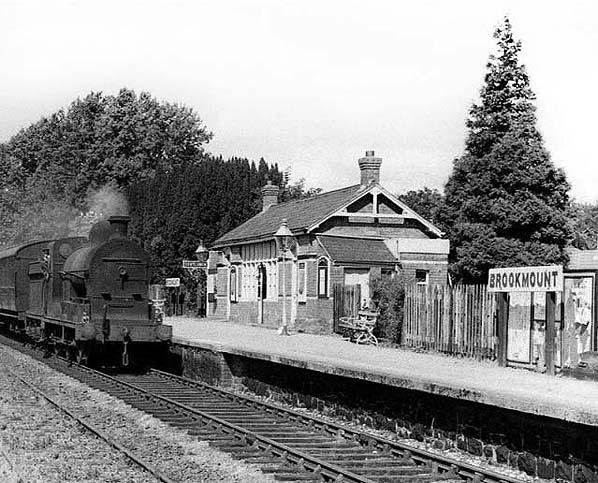
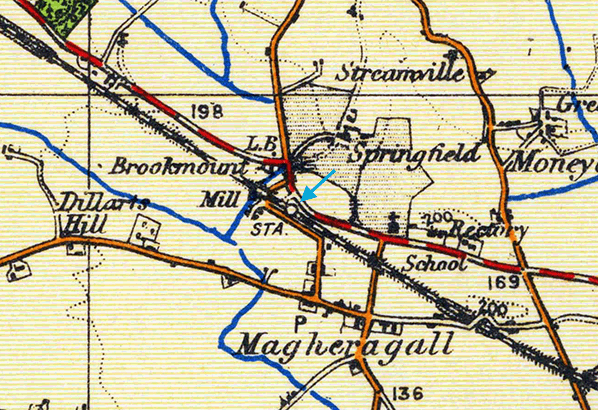
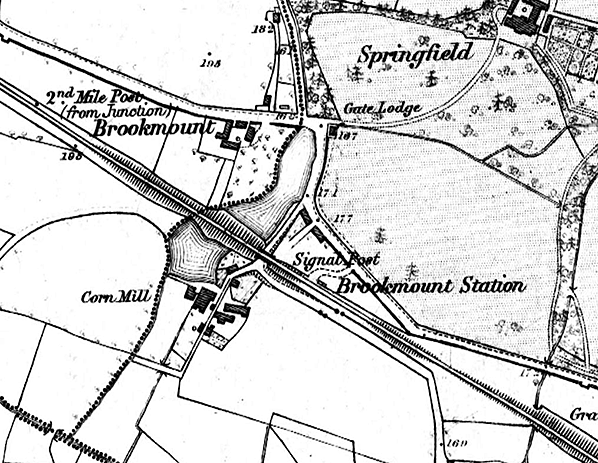
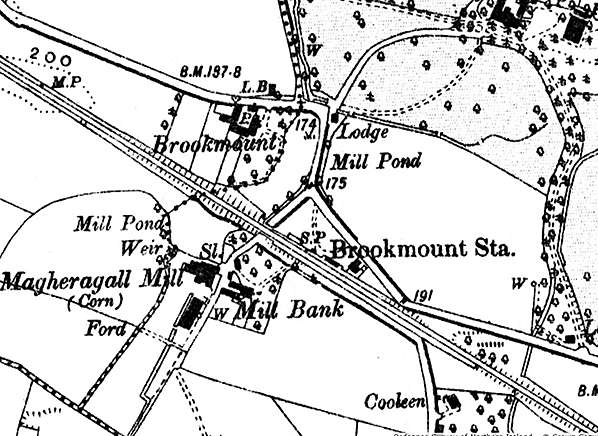

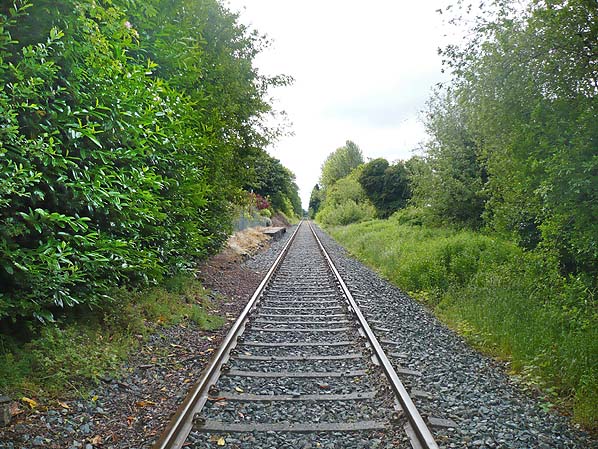
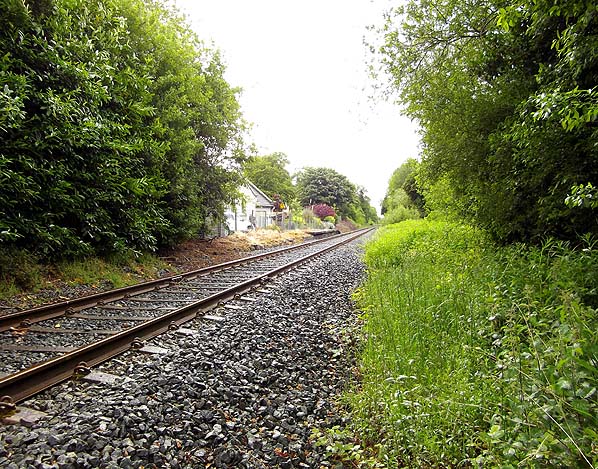
 The line was a single track railway but a loop was provided at Brookmount that served a goods platform on the south side of the line.. The main facilities were located on the north side. At the time of opening this was the up (Knockmore Junction direction) side of the line.
The line was a single track railway but a loop was provided at Brookmount that served a goods platform on the south side of the line.. The main facilities were located on the north side. At the time of opening this was the up (Knockmore Junction direction) side of the line. 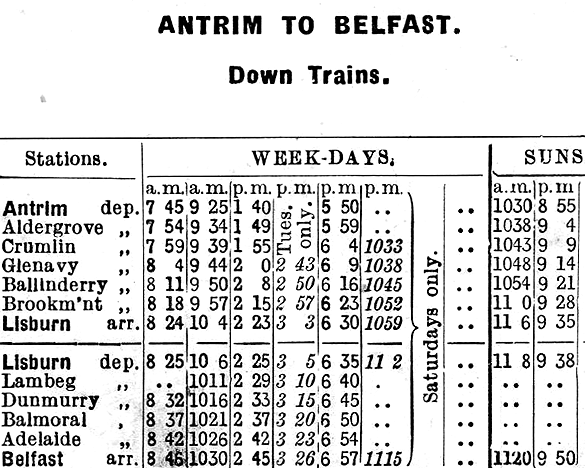
 The 1 September 1956 timetable showed 5 Up trains Monday-to-Friday with an additional service that would call if required. On Saturdays there were 6 Up trains. In the Down direction there were 8 trains Monday-to-Saturday.
The 1 September 1956 timetable showed 5 Up trains Monday-to-Friday with an additional service that would call if required. On Saturdays there were 6 Up trains. In the Down direction there were 8 trains Monday-to-Saturday. 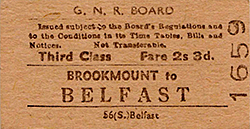
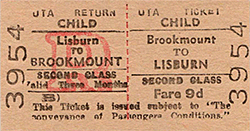

 Home Page
Home Page